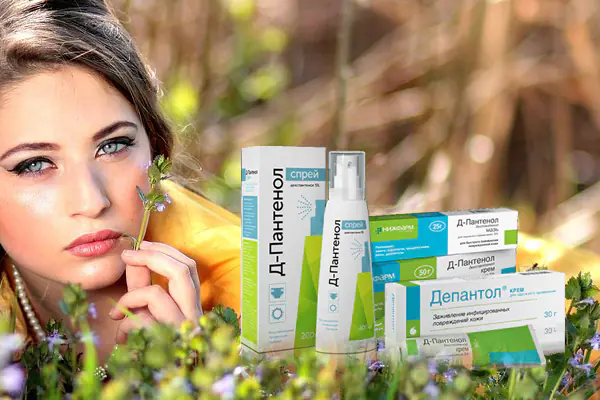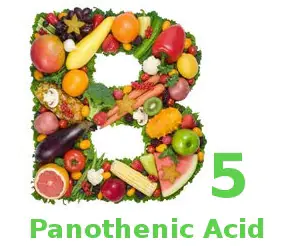Friendship with provitamin B 5 allows you to avoid many problems and eliminate existing problems. So let's get to know our friend better.
What exactly are vitamins and provitamins?
Vitamins - these are substances of organic origin, small quantities of which, while necessary for the normal existence of the mammalian body, are not produced in the body itself or are produced in insufficient quantities. Since the body is not capable of producing vitamins, it receives them from the external environment, mainly from food.
Provitamin is a substance that, after certain chemical transformations in the human body, becomes a full-fledged vitamin.
Obviously, provitamin B5 is converted into vitamin B5.
What is vitamin B5, what is it for and where does it come from?
Humanity became acquainted with vitamin B 5 back in 1931 - the substance was discovered by Roger J. Williams, who studied factors that promote the growth of microbes. Scientists spent a long time figuring out which foods contain vitamin B5, and were surprised to discover that it is present in one quantity or another almost everywhere. Given this fact, in 1933, Williams and Saunders, who actively collaborated with him, logically named the substance pantothenic acid, using the Greek root pantoú, meaning “everywhere, everywhere” in the name.
Pantothenic acid is actively involved in energy formation processes. It is almost impossible to detect a biochemical process in the human body that does without pantothenic acid. This substance, as we have already said, is present in many foods (meat, cereals, herbs, vegetables, fruits, nuts, legumes), and with a normal diet, its deficiency is almost impossible. Problems arise when there are diseases of the gastrointestinal tract with absorption disorders, when certain medications have been taken for a long time (primarily antibacterial agents), when culinary processing of consumed products involves prolonged heating, freezing, canning, etc.
Now let us pay attention to four fundamental points that directly relate to the topic of our article.
1. When researchers tried to find out what vitamin B5 deficiency leads to, and began to feed chickens with foods that lacked pantothenic acid, skin problems were the first to appear. But chicken dermatitis disappeared very quickly after supplementing with pantothenic acid, so at a certain historical stage of study, vitamin B 5 was even called the “anti-dermatitis factor.”
2. It turned out that pantothenic acid is absorbed from the surface of the skin. And for the treatment/prevention of skin diseases, this particular method of delivering the vitamin to the body was considered optimal. This feature of the substance is most relevant in childhood, since absorption through the skin in children is much more intense compared to adults.
3. Provitamin B 5 - a substance known as dexpanthenol. When it enters the body (and it does not matter in what way - by ingestion or through the surface of the skin), dexpanthenol very quickly turns into pantothenic acid.
4. Dexpanthenol is absorbed from the skin surface much faster than pantothenic acid, and after absorption it becomes pantothenic acid also very, very quickly. That is why dexpanthenol, and not pantothenic acid, is used all over the world for the prevention and treatment of skin diseases using topical preparations (i.e. those applied directly to the skin and mucous membranes).
How does provitamin B 5 work? Answering this question is both easy and difficult.
It is difficult because the mechanism of action of dexpanthenol, firstly, is not fully understood and continues to be studied, and, secondly, it is almost impossible to describe in simple words - the most accessible phrase in scientific articles sounds something like this: “... dexpanthenol interacts with lipid segments extracellular lamellae and protein residues in the stratum corneum and thus compensates for the decrease in hydration by maintaining/increasing molecular fluidity...”
What is easy then? It is easy to tell what real, obvious consequences the use of topical dexpanthenol preparations (ointments, creams, gels, etc.) leads to.
So, there are three main effects of provitamin B5:
1-2. Moisturizing the skin and improving its barrier function (i.e., the ability to withstand unwanted external influences - mechanical damage, the influence of household chemicals, urine, etc.). It is these 2 effects that underlie the preventive use of dexpanthenol.
3. Significant activation of skin healing processes, and accelerated recovery is observed for both superficial and deep damage, regardless of their root cause. Thus, provitamin B 5 is active against mechanical damage to the skin, burns (thermal and chemical), and inflammatory processes that arise against the background of diseases of an infectious and allergic nature. It is obvious that the ability of dexpanthenol to stimulate the healing processes of damaged skin underlies its therapeutic use.
Let's summarize.
Provitamin B 5 (dexpanthenol), especially taking into account its activity and safety, turns out to be an indispensable assistant in child care. Preventive use of drugs based on it (primarily ointments) allows you to maintain skin moisture at an optimal level, reduces the likelihood of irritation, diaper dermatitis, and diaper rash. In this case, the best choice would be an ointment that does not contain any dyes or preservatives.
Any, even minor, damage to the skin - dryness, cracks, mechanical damage, irritation associated with exposure to feces, urine, saliva, manifestations of atopic dermatitis, sunburn and much, much more - all these are conditions in which the therapeutic use of provitamin B 5 is justified , is appropriate and highly recommended by pediatricians around the world.
Medical science recommends and doctors in civilized countries have been using dexpanthenol for preventive skin care and therapeutic effects on it for more than 70 years!
Efficiency, the almost complete absence of side effects, a huge range of conditions in which provitamin B 5 is clearly necessary - all this makes the drug based on dexpanthenol an essential component of the home first aid kit.
| D - Panthenol is known for its soothing and anti-inflammatory effect, and is the main component of all after-sun preparations. |
Of course, D - Panthenol has many other benefits and is extremely widely used in cosmetics, but more on that later.
D - Panthenol - that is, provitamin B5, after penetration into the skin, hair or nails, it turns into vitamin B5, that is, pantothenic acid (a natural component present in the skin and hair).
Symptoms of vitamin B5 deficiency include roughness and flaking of the skin, as well as porosity, transparency and accelerated graying of hair.

You may wonder: why don’t we use pantothenic acid (vitamin B5) in its pure form, only some kind of D - Panthenol?
Well, this is because pantothenic acid is very unstable in aqueous solutions (so using it in this form will not have the desired effect), and also vitamin B5 is very poorly absorbed into the skin. It is for these reasons that a stable derivative of vitamin B5, that is, Panthenol, is used in cosmetics. D - Panthenol easily penetrates through the epidermis into the deep layers of the skin (dermis), into the hair fibers (hair roots and their shaft) and the nail plate - after penetration into the tissue it is converted into pantothenic acid.
Panthenol (alcohol) comes in two forms: form L and form D. Both forms have proven themselves to be excellent in moisturizing skin and hair, but only form D (D - Panthenol) is converted into vitamin B5 (biologically active form).
Panthenol is a thick, transparent, viscous liquid of light yellow color. Very soluble in water, alcohol, ethylene and propylene glycol, but not soluble in fats. Panthenol has a high affinity for certain proteins, especially keratin (which is why it is so useful in skin, hair and nail care). Stable over a wide pH range of 3-8 and resistant to heating.
For the production of cosmetics, a 75% aqueous solution of D - Panthenol is used. Its presence in the cream makes it easier to apply, and its beneficial substances penetrate deeper into the skin.
Panthenol content in cosmetic products:
— in cosmetics for face and body it is used in a concentration of 1-5%;
— hair shampoos — 0.5-1%;
- hair conditioners - 0.25-1%.
D-Panthenol - properties and action
Leather:
— well tolerated by the skin, non-toxic, non-irritating and non-allergenic (there are practically no cases of skin irritation or allergies from D-Panthenol);
- easily penetrates through the epidermis into the deep layers of the skin (dermis), as well as hair and nails - thanks to micro-particles;
— effectively moisturizes the skin, reduces water loss through the epidermis, giving the skin softness and elasticity;
- stimulates cell division (in the layer of the basal epidermis), this is how the restorative and healing agent works. Thanks to these properties, it helps in the healing of wounds and minor skin damage (accelerates the healing of various skin damage), and also has a good effect in the treatment of scars;
— accelerates metabolic processes in the skin;
- has a soothing and anti-inflammatory effect - well suited for damaged skin and sensitive skin care, effective for burns, soothes irritations caused by allergens (relieves allergy symptoms), and also soothes the skin after depilation and shaving - eliminates redness, itching and other signs of irritation ;
- does not clog pores, therefore does not cause the formation of comedones;
- improves the lipid barrier of the epidermis - vitamin B5 is necessary for skin cells to synthesize the so-called coenzyme A (it is its element). Coenzyme A is necessary for normal cellular metabolism, and by increasing lipid synthesis, it strengthens the skin's protective barrier (lipid layer) and protects it from irritation.
Hair:
- moisturizes, softens and smoothes hair fibers;
— after use, the hair becomes voluminous and easy to style;
— gives hair shine, makes it easier to comb and prevents split ends;
– protects hair from mechanical damage and increases resistance to external factors (for example, too high or low temperature, sea water);
- one of the best hair strengthening products;
Nails:
— improves the condition of the damaged nail plate (moisturizes and strengthens it);
- improves the hydration of the nail plate, its elasticity, hardness and strength.
D-Panthenol – application:
— antiseptic care products, moisturizing and relieving irritations;
- the main component of after-sun cosmetics (creams, lotions, milk, foams, sprays);
— non-greasy cosmetics (reduces redness and itching);
— cosmetics for children;
— anti-allergenic cosmetics;
— emulsions after burns;
— after shaving and depilation products (milk, lotions);
- care products for dry, dehydrated, thin, sensitive and irritation-prone skin (for example, creams, serums, balms, masks);
- shampoos, conditioners and hair masks (D - Panthenol has a high affinity for keratin, so it is well absorbed by the hair);
- nutrients for nails;
— recently, panthenol has also been a frequent component of “anti-age” cosmetics, which inhibit skin aging and have a stimulating effect. D-Panthenol stimulates cell division, which leads to accelerated regeneration of skin cells. In addition, it has a protective effect, which prevents the occurrence of irritations that can leave damage to the skin. If we add to this the strong moisturizing effect of panthenol and its high affinity for keratin, then it really is a necessary component of cosmetics for mature skin.
Skin manifestations of pantothenic acid deficiency
Vitamin B5 deficiency manifests itself on the skin as follows:
- keratosis or excessive peeling of the epidermis;
- pigmentation;
- hair loss and/or accelerated graying of hair.
D – Panthenol has a wide range of uses. Therefore, it is worth using its beneficial properties in everyday skin, hair and nail care.
In 1931, scientists managed to synthesize vitamin B5, after researching which it turned out that it is present almost everywhere. It is also called pantothenic acid, translated from Greek “pantoten” means “everywhere” or “everywhere” and this is not in vain because vitamin B5 takes part in almost all metabolic processes in the body and is found in almost all products.
Vitamin B5, like all B vitamins, is a water-soluble vitamin; it has no toxic properties and is excreted from the body in the urine. Pantothenic acid also has the property of being converted into other substances; when it enters the body, it turns into pantheine - and this is the main part of coenzyme A, which is involved in the synthesis of proteins, fats and carbohydrates.
Vitamin B5 slows down aging and prolongs life!

Benefits of Vitamin B5 (pantothenic acid)
Vitamin B5 takes part in almost all processes that occur in the body. Therefore, its benefits are very difficult to overestimate.
Pantothenic acid has the most direct effect on hair, probably more than all other vitamins. This is due to the fact that vitamin B5 is involved in lipid metabolism, in the formation and renewal of cells, its deficiency directly affects hair loss, exhaustion and deterioration of hair structure.
Vitamin B5 is very important in the production of adrenal hormones, red blood cells and amino acids, it promotes rapid healing of wounds on the skin and mucous membranes. Pantothenic acid is involved in the synthesis of proteins and carbohydrates for energy, and it also has an anabolic effect, which allows you to build muscle mass and reduce the amount of energy spent. This vitamin is also responsible for long-term memory.
Vitamin B5 is used in procedures for skin rejuvenation; it is often added to children's creams and gels against skin rashes, irritations and dermatitis.
To ensure the synthesis and metabolism of all substances necessary for life, it is important that pantothenic acid is present in the body in sufficient quantities.
Vitamin B5 helps the absorption of other vitamins: folic acid, vitamin C and vitamins B1, B6.
Indications for use
Vitamin B5 is very important for hair health, especially in case of hair loss, but besides this, pantothenic acid has many more indications for use:
- baldness;
- dandruff;
- eczema;
- burns, ulcers;
- trophic ulcers;
- neuralgia, paresthesia, polyneuritis;
- tuberculosis;
- pancreatitis;
- chronic liver diseases;
- bronchitis, pneumonia, bronchial asthma;
- disorders of the circulatory system;
- diseases of the gastrointestinal tract associated with high acidity;
- metabolic disease;
- toxicosis in pregnant women;
- allergic reactions (dermatitis);
- hyperthyroidism;
- cystitis;
- candidiasis;
- arthritis.
It is also recommended to increase the amount of vitamin B5 during heavy physical activity and intense sports.

Symptoms of vitamin B5 deficiency
In medical practice, vitamin B5 deficiency is rare, since it is found in many foods, so its deficiency can be caused by diets, poor nutrition, dysbiosis and other gastrointestinal problems. Another cause of vitamin deficiency can be taking contraceptives, sleeping pills, as well as alcohol and smoking.
The main symptoms of pantothenic acid deficiency:
- rapid body fatigue, chronic fatigue;
- depression, despondency;
- irritability and poor sleep;
- hair loss;
- peeling of the skin;
- muscle pain, heaviness in the legs;
- headaches, sometimes nausea;
- diseases of the small intestine, stomach pain;
- decreased immunity, the body cannot protect itself from various infections.
These are not all the symptoms that vitamin B5 deficiency causes; in addition, these symptoms or similar ones can be caused by a lack of other vitamins and microelements, but only a doctor can diagnose a lack of this vitamin. If you notice the symptoms described above, go to your doctor for a consultation.
To determine the amount of pantothenic acid in the body, one of two available methods can be used: microbiological or radioimmunological. For testing, blood is taken in the morning on an empty stomach.
The need for vitamin B5 for hair
This vitamin is simply vital for the health of our hair. Vitamin B5 or pantothenic acid for hair works in several directions at once; if the body does not receive enough vitamin B5, this immediately affects the condition of the hair. Vitamin B5 is indispensable for hair loss; it is included in the most expensive anti-hair loss products from world brands. In addition to treating hair loss, vitamin B5 also stimulates hair growth and awakens new hair to more intensive growth.
Vitamin B5, B6 and B12, vitamin C and iron are the main components of hair loss treatment!
Pantothenic acid is also important for hair because it retains moisture in the hair, which means that the hair becomes more elastic, less dry and brittle, and less split ends. After a course of vitamin B5, hair becomes more voluminous, smooth, shiny and silky.
Vitamin B5 is unique in that it is well absorbed by the skin, so it is often added to cosmetics and used for homemade hair masks.

Foods rich in vitamin B5
Vitamin B5 is easily destroyed during heat treatment of foods - more than 50% loss and freezing - about 30%, so you should, if possible, avoid heat treatment of foods and eat raw vegetables and fruits.
Vitamin B5 is found in both animal and plant products. Most pantothenic acid is found:
- Brewer's yeast;
- beef, chicken liver;
- beef;
- sea fish;
- fish roe;
- eggs;
- kidneys, heart;
- mushrooms;
- nuts;
- Rye flour;
- fresh vegetables;
- dairy
- sprouted wheat
- honey, pollen, propolis.
Table vinegar added to salad or preserves completely destroys vitamin B5.
Vitamin B5 in foods is absorbed only during normal functioning of the gastrointestinal tract, because it is absorbed in the small intestine and in small quantities in the large intestine, so any disturbances in the digestive tract and microflora disorders lead to a decrease in the absorption of pantothenic acid.
Where to buy vitamin B5 (pantothenic acid)
Preparations containing vitamin B5 (pantothenic acid) can be bought at the pharmacy; it can be in the form of tablets, injections and complex preparations that include vitamin B5; there are also different dosages of the vitamin. A healthy adult needs about 10 mg of pantothenic acid per day, in some cases the dosage may be increased (during breastfeeding, sports and certain diseases).
The daily requirement of vitamin B5 should not be confused with the dosage prescribed by the doctor.
The most commonly used medicine is calcium pantothenate in tablets.



